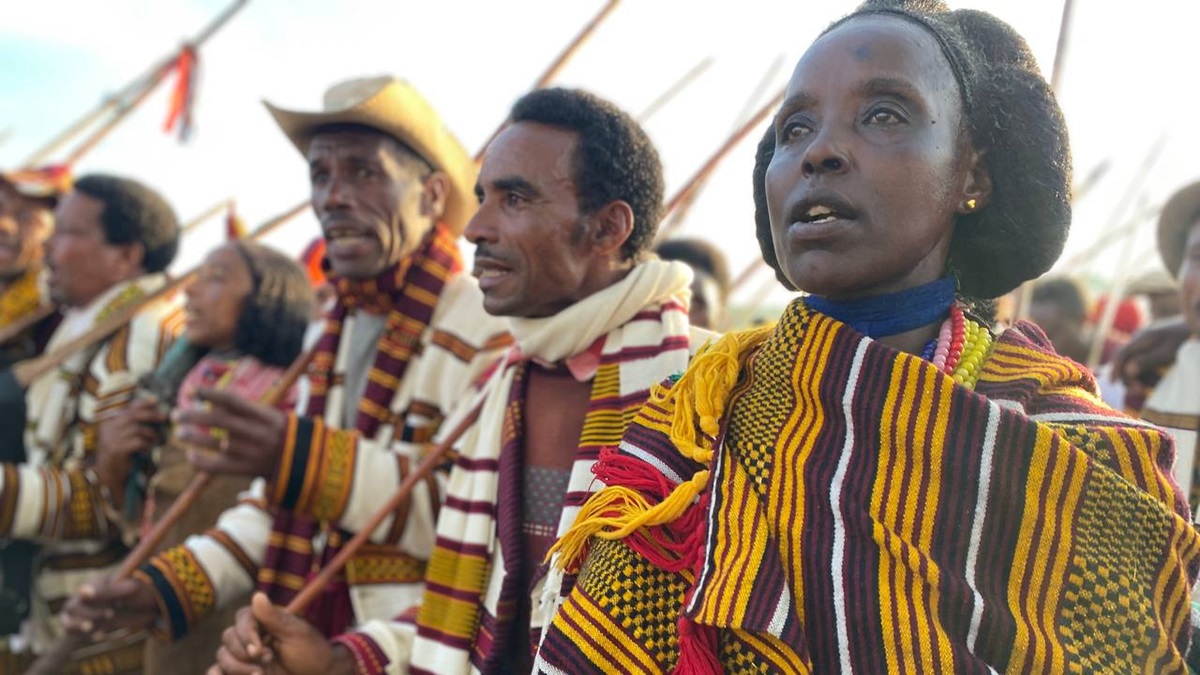#OromoProtests: The “Oromo street” and Africa’s counter-protest state – Part II
Commentary
Etana Habte, Special to Addis Standard
In the first part of this series, I explored in historic perspectives (particularly with developments in Oromia regional state) the Ethiopian government’s road to becoming a counter-protest state, and proceeded to discuss the systematic ways in which the regime further bolstered its role as a counter-protest state in Oromia. Taking the recent #OromoProtests as a point of departure, in this part of the series I discuss a more recent surge of popular protests, and the socio-political and party architecture in which #OromoProtests first took shape.
The EPRDF-led regime’s ‘decentralization of power’ down the hierarchical administrative structures of the regional states discussed in the first part was also the beginning of how the so called rural, previously isolated communities, experienced the heavy handedness of a central repressive government (the falsification of ‘nation’, and its clearly underlying failures). It is an expression of failures because this type of response is a mark of states that ignore an alternative to their texts of national dialogue and whose intents exemplify regional and ethnic primacies.
The “Oromo Street”: A force derailing Africa’s counter-protest state
By going beyond economic and development topics – which remain very important – this section explores concepts that better explain the roots and trends of these protests, it then outlines dimensions of confrontations between protesters and the Ethiopian counter-protest state.
The importance of looking inward at the course of modern Oromo political activism and its relations with the Ethiopian state cannot be underestimated: tounderstand the roots of Oromo protests we must focus on specific demands in the process and progress of modern Oromo political activism. There are society-state relations toreflectupon that reveal some of the underlying patterns that have made up and shapedthismovement.
Three closely associated features underlying Ethiopia’s society-state relations take form mainly during the incumbent’s rule of the last 25 years: growth of coherent consciousness,decades of simmering tensions,and ‘emergence of the Oromo street,’. In an attempt to look inside the Oromo nation at various levels it is important to analyze salient factors in decades of ‘constructions’ that led up to the recent Oromia wide protests.
The modern shaping of ‘the Oromo Street’
Worldwide, the upsurge in popular protest became a powerful tool of global political movements. People throughout the world have been taking to the streets, giving new life to a form of political movement ‘often thought of as a historical relic in today’s era of expanding security states and the apparent triumph of global elites.’ Given recent global protest movements mentioned in the first part of this series, Ethiopia by any standard is not alone in encountering an upsurge in popular movement.
All the major waves of protests in Africa have been by and large limited to urban centers, and when they involve rural areas it has been termed as ‘isolated’ movements. The same is true with the 2005 post election protests in Ethiopia. Oromo protests however have created in Ethiopia a unique ‘street of protests,’ which I refer to as “the Oromo Street.”
The Oromo Street brought together rural and urban protests – those on the ground and online via social media. Areas previously believed to have been ‘isolated and disparate’ have found themselves at the centerof the protest because of the combination of the ground and online (new media technologies and platforms, such as Facebook, Twitter and Instagram). (Daniel Miller’s, Tales From Facebook expands upon the concept of individuals as networking sites, and examines in detail how Facebook transforms the lives of particular individuals).
Merely seven months after Ethiopia’s ruling party declared a 100 per cent landslide victory in the national election, Oromia, the country’s largest federal state, was placed under full military ‘control’ as protesters swept through the streets in an unprecedented opposition against the ruling EPRDF.
Ignited on 12 November 2015 at Gincii Senior secondary School in central Oromia, the peaceful protests quickly spread as far west asOromia’s outer margins neighboring the Sudan. It then turned north and took the Tuulama Oromo on the train. Whilst continued unabated in the west and north, protests swiftly engulfed eastern Oromo provinces before they reached southern Oromia. Waves of protests quickly engulfed the whole region in merely three weeks between 12 November and 5 December. As rural Oromia and higher education institutions became the scene of Oromo protests, elementary school children and secondary school students also joined the protests – rare in Ethiopian history. In the following weeksthe movement captured, in a rather unusual fashion, federal universities beyond Oromia – Dilla and Hawassa Universities in Ethiopia’s south. Much like federal universities in Oromia, junior colleges, technical and agricultural colleges in Oromia also joined, forming the first and most important “Oromo Street.”
After taking all of Oromia student protests instead took the shape of a well-organized Oromo national movement. This illustrates a distinction from all of its precedents in another feature — it enjoyed a considerable size of support from the Oromo public. Peasants, merchants, unemployed urban youth and some government employees were seen rallying behind student protesters.
That the protests were triggered by a scheme that the Horn of African state called “the Addis Abeba Integrated Development Master Plan,” commonly known as ‘the Master Plan,’ is now exhausted and need not be repeated here. Rural Oromia, and of course urban centers become another productive dimension of the ‘Oromo Street.’
In less than four weeks what the Oromo people regarded as a serious threat to their national identity caused a massive popular movement that engulfed the whole of Oromia. On this occasion no political party made a call; no underground national leadership seem to exist either. The only Oromo opposition party, OFC, live under a constant threat from the state. All but two or three of its national leadership were imprisoned in the waves of arbitrary arrests the regime launched following the start of the movement. Almost all of its members, supporters and sympathizers throughout Oromia have also been jailed, exiled or at the worst killed.
In the course of this popular Oromo movement we heard of OFC’s voice only rarely for understandable reasons. There is no readily available institution to have caused such a regime shaking popular movement. This geographical spread suggests that Oromo protests, despite many precedents in Ethiopia, and Africa at large, are not limited to urban centers; it is at the same time a phenomenon in the rural areas. Even goingbeyond these locations Oromo protest movement gave birth to another productive dimension to its ‘Street’: supporters from the country and an Oromo diaspora connected on social media.
But there is another equally important “Oromo Street.” When modern Oromo political activism was denied a space and every element it possessed began to be systematically criminalized by the same state which legitimized and fostered its growth, it found another informal space as the ruling party opened its door widely for Oromo nationalists to join it as OPDO members.
Ignore at own peril
Between 2006 and 2010 in particular, stifling voices of dissent came to a systematic twist when OPDO invitedthe Oromo youth to become its party members and undertook appointments of middle level cadres from the so called new generation. Given such compelling circumstances however OPDO’s inflated membership turned out to be an instrument of economic, social and political mobility than agenuine political loyalty.
It is at this point that the architecture of repression the regime has built over the last decade under the name of ‘development’ unequivocally met its match: Oromo nationalism.Young nationalist Oromo civil servants, intellectuals and bureaucrats who, before 2006, were sought after, detained and persecuted on allegations of being “OLF members,” “anti-development,” or “anti-peace” were given an opportunity to join the rank and file of OPDO. In doing so, the ruling party believed that it could afford to use- within its structures and leadership – active and politically conscious Oromo nationalists to speak on its behalf and in the process restrain Oromo nationalism. Alas, as events gradually unfolded, this perception of the ruling party rather tended to be counterproductive.
When the EPRDF recently commended its national membership having reached seven million, it failed to realize that hundreds of thousands of Oromo nationalists who wished to work in earnest – and even openly through #OromoProtests – towards the interests and narratives of an Oromo national construct and against the regime, make up a significant portion of that number. When the regime took for granted that it had successfully silenced dissenting voices (particularly in Oromia), it felt safe and relaxed as an electoral authoritarian regime in declaring landslide victories in two consecutive national elections (2010 and 2015). In contrast, modern Oromo political activism was now brewing in its own turf than it has been among the opposition. When the protests broke out in November 2015 and engulfed the whole of Oromia in early December, there was little surprise that one of its immediate achievements was the dismantling of the sub-kebele institutions (gooxii and garee), the main vehicles of control and repression.
While the regime’s policy of claiming Oromo nationalists by recruiting theminto the rank and file as well as into middle level leadership of the OPDO went unabated, in practice it became a creation of formal forum where unconscious and semi-conscious Oromos meet politically conscious and articulate Oromo nationalists. The result was that the OPDO rank and file from kebele levels to the regional bureaus over the last ten years became heavily politicized and very much indoctrinated with the narratives of Oromo nationalism.
Although aware of what was going on within the OPDO, the TPLF dominated EPRDF and the state intelligence structure appear to have perceived it as insignificant; after all, all were de factomembers of the ruling party which had ‘their hands tied and their mouth muzzled’ with party rules and regulation. Besides, since party bylaws allow a process of free discussions, debates and arguments within party members at all levels there has not been any unified method with which the ruling EPRDF can tackle or even hinder these processes. A participant in the processes who was once an OPDO cell leader at one of Oromia’s regional bureaus tells me his experience:
Using the forums set aside for lower level political cadres, ideas raised by participating members, friction of thoughts as well as deficiencies and mistakes of EPRDF were widely reflected upon; the structure allowed for the members to [openly] argue that the overall objective of their party has been wrong. This gave them more opportunity to see internal deficiencies of the party more closely than when they had been outsiders. When they saw that the party has been unresponsive to the demands of their people and more importantly their suggestions many, in the years after 2005, seem to be convinced that the Oromo people need to look for alternative [forums]. I personally know the fact that many young party members became aware of the complex internal problems of the party- both horizontal and vertical (OPDO-TPLF) – has no solution at all. More importantly, participation in the party by the new generation of [politically conscious] Oromo youth called into question political opinions of senior politicians regarded as founders of the party. It is safe to say that most of pre-2005 OPDO members were people of very low education; many of them do not question legality and validity of existing principles and directives under which they serve. Those who joined the party after 2005 were the same students who had been in various schools and universities protesting against the government on behalf of their people and some of them were even leaders of such movements. Since the new members perceive themselves more as part of the society than the party itself, the political debate and arguments they injected into the party structures through the same forums of discussion the party offers at various levels made many members to squeeze their own regime with serious questions. This I believe contributed to the growth of political consciousness within the party and more broadly within the Oromo people, and can safely be stated as having contributed to the on-going Oromo protests.
These circumstances suggest that narratives of the Oromo national struggle centred on Oromummaa/Oromoness (Oromo national identity) have become nurtured through state resources. Clear evidence of this is how in April 2014, the OPDO party structure along with the Oromia regional state bureaucracy made the region’s TV to quickly televise a highly contested debate by OPDO officials openly rejecting, on behalf of Oromo national interests, the state proposed-turned-controversial “Master Plan.”
That Oromo nationalism has raised enough political consciousness not only within the masses of Oromo youth – especially college and university students – but also within the OPDO rank and file. This was demonstrated when an OPDO member who was the mayor of Sulultaa, north of the capital Addis Abeba, boldly aired his objection in a televised meeting allegedly convened to launch “training of trainers” on “the Master Plan.” He openly and eloquently spoke against the proposed “Master Plan” saying: “The question of [how to handle] Addis Abeba city and the surrounding towns [of Oromia] is not an issue of urban matter, it is a matter of identity. When we raise about identity we have to pursue a fundamentally necessary route in which the development of Addis Abeba and the surrounding towns can be addressed in a way that the rights of the Oromo nation can be protected and where the identity politics and history cannot be ignored…”
The way the mayor conceptualized issues surrounding “the Master Plan,” and expressed his fierce opposition to it, has exactly been the same way Oromo protesters spoke against it throughout Oromia. As thesemiddle level cadres strongly tied the subject to some looming danger on the Oromo identity in its entirety, the federalgovernment resorted to reject all concerns underlining that “the Master Plan” would be implemented regardless of what OPDO or the Oromo public may think. This proved the public discourse that “the Master Plan” is a deliberate attempt to dissect Oromia and was perceived throughout the region as a blunt offensive on Oromo identity by the regime. In fact, this time the protest against “the Master Plan” in its finest form began within the EPRDF, not among the Oromo students at various colleges and Universities. Indeed, the first round of the April-May 2014 Oromo protests against “the Master Plan” began in Ambo, 120kms west of the capital, and spread to other parts of Oromia immediately after this fierce debate between OPDO party members against the plan was first televised.
There is very little doubt that Oromo nationalist members of OPDO, now the larger part of its rank and file, were able to manipulate the inner circles of the party for that meeting to be quickly televised. This is so partly because the discipline and mechanisms of control required to advance this kind of argument and debate are very much linked to the interests of the de facto ruling party which will not allow such objections to last long; and partly becausethe act carries sizeable risk for few OPDO officials. Given the fact that the state intelligence, federal police and many other powerful state structures were and are under TPLF control, some of those who spoke against “the Master Plan” in public could have risked death and disappearance. To throw it to an Oromo pubic packed with grievances was, therefore, a safe political bet and a powerful instrument to fight againstthe ever growing manipulative political asymmetry within the EPRDF.
The Adama meeting of April 2014 was a typical manifestation of deep-seated tensions between the Oromo people and the regime in power. While OPDO officials who sided with demands of the Oromo people used the country’s constitution as “weapon of the weak,” only to ask for previously suspended right of Oromia’s self-rule, senior members of the central government used thinly veiled language to express their right of rule over the whole country. The course of the current #Oromoprotests movement to win over the proposed “Master Plan” became a manifestation of growth in coherent consciousness mobilized under the shade of Oromo national identity. By November 2015 there is little surprise that the situation throughout Oromia was ripe for a fully-fledged uprising.
In the third and final part of this series, I will take a close look at the decades old simmering tensions between parties, discovering what they reveal about the politics of the Ethiopian counter-protest state.
______________________________//________________
Ed’s Note: Etana Habte is a PhD Candidate at the Department of History, SOAS, University of London. He can be reached at:ittaanaa@gmail.com







